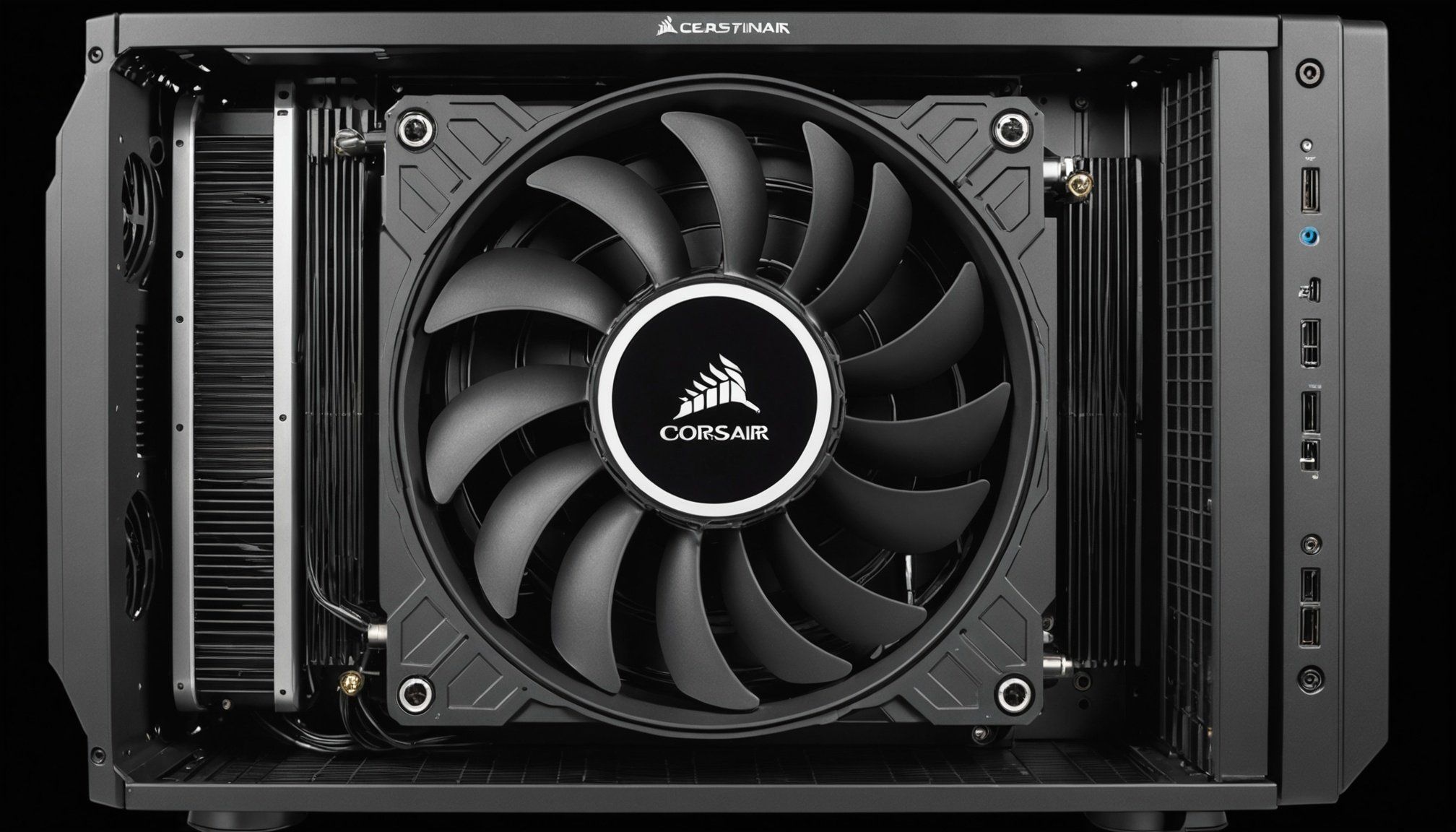Overview of Corsair Crystal Series 680X
The Corsair Crystal 680X stands out with its case design, offering superior features tailored for enthusiasts. Notably, the dual-chamber layout enhances organization, ensuring that even the most complex systems remain tidy and efficient. With tempered glass panels, the visual appeal is matched only by its functional innovation.
In terms of airflow, the architectural design fosters enhanced cooling capabilities. The upper chamber supports optimal airflow pathways, which is crucial when handling high-performance hardware. Adequate airflow directly impacts cooling efficiency, particularly in dual GPU configurations that demand superior airflow management.
This might interest you : Unleashing Gaming Excellence: Building a Top-Tier Rig with Intel Core i7-11700K & NVIDIA RTX 3070 in the Stunning Lian Li PC-O11 Dynamic
Key Features
- Dual Chamber Design: Segregates components for improved organization and cooling.
- Tempered Glass Panels: Offers aesthetic value while allowing for visual inspection of internal components.
- Enhanced Cooling Potential: Supports up to eight fans for robust airflow possibilities.
This case design is particularly beneficial for users requiring efficient airflow management. If you’re planning a build with dual GPUs, consider the importance of fan placement and airflow balance. You can take advantage of the expanded room for cooling components to achieve desirable thermal performance without sacrificing style or accessibility.
Understanding Airflow Dynamics
In computer cases like the Corsair Crystal 680X, effective airflow management is paramount to maintaining optimal cooling efficiency. Recognising the basics of airflow can help maximise the potential of your dual GPU configurations. It’s essential to consider how air flows from intake to exhaust, ensuring your system remains within safe temperature ranges.
Have you seen this : Mastering Airflow and Cooling: Key Strategies for Small Form Factor Cases Featuring the Intel Core i7-10700K
Key factors that influence cooling efficiency include proper fan placement and maintaining a balanced airflow. Installing intake fans at the front and exhaust fans at the back and top helps create a smooth airflow path, crucial for dispersing heat effectively. Adopting a balanced airflow is a strategy focusing on matching air intake with exhaust – known as positive airflow. It’s often preferable as it aids in maintaining a dust-free environment within the case.
On the contrary, negative airflow might result in pressures that draw dust into the system, potentially affecting both cooling and component longevity. Thus, the balance between intake and exhaust fans plays a significant role in achieving optimal cooling efficiency. Understanding these dynamics ensures not only performance but also the longevity of your build.
Optimal Fan Configuration
Achieving a balanced fan configuration is crucial to maintaining an efficient cooling setup in your Corsair Crystal 680X case. Understanding the optimal placement and type of fans can significantly impact cooling performance, especially when utilising dual GPU configurations.
Front, Top, and Rear Fan Placement
For the front fan placement, it is recommended to install intake fans that effectively pull cool air into the case. This helps to maintain a steady airflow across critical components. Meanwhile, the top and rear fan placement is ideal for exhaust fans, pushing hot air out of the case and keeping the internal temperature in check. Avoid positioning fans that create turbulence as this can lead to inefficient cooling and increased noise levels.
Choosing the Right Fans
When it comes to selecting fans, consider the options between PWM (Pulse Width Modulation) and non-PWM fans. PWM fans offer better control over fan speed and noise levels, making them ideal for those concerned with sound denoising while ensuring high airflow performance. Take the time to compare options from reputable brands known for quality and reliability in fan design.
Fan Speed Control and Monitoring
Managing fan speed is crucial for optimal cooling and maintaining the longevity of components in the Corsair Crystal 680X. Efficient fan speed control ensures desired temperature levels without excessive noise.
Tools for Monitoring Performance
It’s important to have the right tools to monitor fan performance accurately. Software like Corsair’s iCUE or MSI Afterburner provides features for overseeing and adjusting fan speeds in real time, which helps keep your system running optimally. These tools enable users to monitor temperature and fan RPM, alerting them to potential overheating before it becomes an issue.
Recommended Software for Automatic Control
The right software can simplify automatic fan control, adjusting speeds based on current demand. iCUE offers customisable fan curves to handle varying workloads, maintaining efficiency and reducing unnecessary noise. For broader compatibility, SpeedFan is a versatile choice, suitable for numerous systems and cases.
Controlling fan speed manually is a thing of the past. These advanced tools offer peace of mind to users by automating thermal management, ensuring silent, efficient cooling. Balancing performance with noise is easily achievable through smart fan speed management.
Thermal Performance Assessment
Understanding thermal performance is essential for maintaining your Corsair Crystal 680X setup. With temperature monitoring, you can pinpoint precise points of efficiency and potential overheating. Begin with tools like HWMonitor or Core Temp to receive accurate readings of CPU and GPU temperatures. These tools track temperature in real-time, providing data that is crucial when assessing thermal efficiency.
For performance assessment, consider using software like AIDA64, which offers comprehensive solutions for stress testing hardware. These applications help simulate demanding conditions, revealing how well your cooling setup responds to intensive tasks. By analysing the data acquired from these tests, users can adjust fan speeds and positioning, ensuring optimal cooling.
Accurate measurement plays a pivotal role in interpreting results. If readings consistently show temperatures exceeding recommended thresholds, it might indicate insufficient airflow or inadequate cooling components. It’s essential to take corrective actions, such as improving airflow management or upgrading cooling solutions, to mitigate overheating risks.
Utilising these methods empowers users to optimise thermal performance, maintaining system stability and prolonging component lifespan. Precise temperature monitoring and correct interpretation ensure that your system runs smoothly under varying loads.
Recommended Cooling Solutions
Choosing the ideal cooling solutions for your Corsair Crystal 680X is pivotal to enhancing performance, especially with dual GPU systems. Understanding the distinction between liquid cooling and air cooling can elevate your configuration’s efficiency.
Liquid cooling generally offers superior thermal conductivity, efficiently absorbing heat from the GPU and CPU. This method often results in lower noise levels and can significantly reduce temperatures during intensive operations. Popular liquid cooling systems like the Corsair Hydro Series provide robust solutions suitable for enthusiasts seeking optimal performance.
Alternatively, air cooling is cost-effective and involves simpler installations. High-quality aftermarket coolers, such as those from brands like Noctua, deliver reliable cooling with excellent airflow management. Supplementing your setup with components like thermal paste can enhance thermal contact between heatsinks and components, improving heat dissipation.
For systems craving maximum efficiency, consider a hybrid approach, utilising both liquid and air options to manage diverse thermal demands. When selecting cooling solutions, balance the price, performance, and noise level tailored to your computing needs, ensuring each component contributes to overall cooling efficiency. Such enhancements directly contribute to achieving a stable and high-performing system build.
Troubleshooting Common Cooling Problems
Addressing cooling issues in dual GPU setups is crucial for maintaining peak performance. Begin by identifying overheating signs, such as frequent system crashes, increased fan noise, and visible temperature spikes on monitoring tools like HWMonitor or Core Temp. Once recognised, these indicators can guide you towards effective troubleshooting methods.
Common causes of airflow restrictions may include obstructed vents, poor cable management, or improperly placed fans. Inspect your Corsair Crystal 680X for these impediments and rectify them by keeping vents clear and securely organising cables. Pay attention to fan placement — incorrect positioning might hinder optimal airflow and exacerbate heating. Ensuring intake fans face clean airflow paths while exhaust fans expel hot air effectively is essential.
If thermal performance continues to disappoint, consider steps like reapplying thermal paste or investing in additional cooling solutions. High-quality aftermarket coolers may provide the needed boost in cooling performance. Finally, revisiting fan speed settings with software like iCUE can automatically adjust speeds based on thermal demands, maintaining the delicate temperature balance. These actions foster a conducive environment for the unhindered performance of dual GPU setups, ultimately enhancing overall system reliability.











